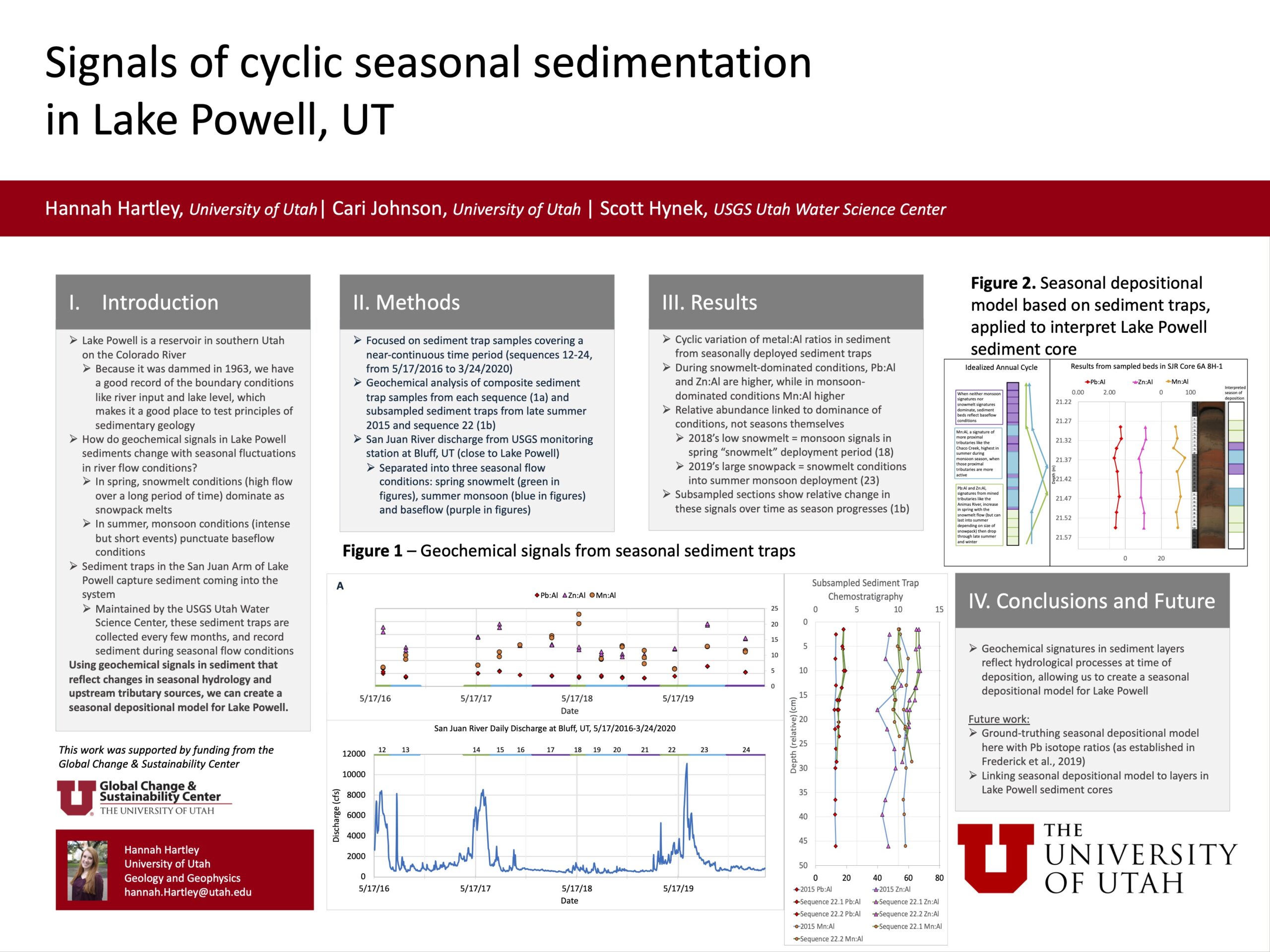Signals of cyclic seasonal sedimentation in Lake Powell, UT
–Hannah Hartley, Cari Johnson, Scott Hynek
[bs_collapse id=”collapse_bb86-afd7″]
[bs_citem title=”Bio” id=”citem_e610-6c22″ parent=”collapse_bb86-afd7″]
I am currently a Master’s student working with Cari Johnson. My research focuses on unraveling the history of Lake Powell and how lake level and environmental change is recorded in its sedimentary record.
[/bs_citem]
[bs_citem title=”Abstract” id=”citem_eca8-96a7″ parent=”collapse_bb86-afd7″]
Lake Powell, a reservoir in Southern Utah, offers a unique opportunity to investigate how external forcings are reflected in the sediment record. After being dammed in 1963, environmental conditions have been meticulously recorded. This record can be compared to sediment deposited in Lake Powell to determine how the sediment reflects environmental changes like lake level or seasonal tributary activity. Sediment traps in Lake Powell capture sediment coming into the system from the San Juan River. These traps are collected roughly three times per year, so they record specific intervals of deposition. Geochemical analysis of the sediment from those traps allows us to identify how upstream tributary activity correlates to downstream sediment layers in Lake Powell, and how sedimentation changes through the year. Using the seasonal depositional model established by the sediment traps, we can track seasonal change in sediment cores, which record the entire history of Lake Powell.
[/bs_citem]
[bs_citem title=”Narrative” id=”citem_780c-0f71″ parent=”collapse_bb86-afd7″]
Lake Powell is a reservoir in southern Utah which impounds water from the Colorado River and the San Juan River. It was dammed in 1963, which is recent enough that we have great records of how it has changed over time. Because of this, it’s an ideal natural laboratory to figure out how geochemical signatures in the sediment relate to upstream tributary signatures. In order to do so, sediment traps that record seasonal sediment deposition were analyzed and compared to flow conditions, which transmit water from different tributaries depending on which are most active. The lower chart in figure 1a shows the discharge from the San Juan River taken at Bluff, Utah, (just before the river enters Lake Powell) from 5/17/2016 to 3/24/2020. You can see seasonal variation in flow each year – discharge is highest in spring, then lower, punctuated by smaller monsoon events during summer. The sequence deployment periods are labeled above the discharge (spring snowmelt is green, summer monsoon is blue, and baseflow is purple). In the upper chart, Pb:Al, Zn:Al, and Mn:Al ratios from each sequence are plotted against the time axis. You can see cyclic variation in these ratios corresponding to discharge. Pb:Al and Zn:Al tend to be higher in sequences from snowmelt flow, and drop when the flow is lower. By contrast, Mn:Al is relatively higher in summer sequences and lower in spring conditions. This suggests that the different flow conditions, which deliver water from different tributaries, deposit sediment beds with unique geochemical signatures. Figure 1b shows these ratios plotted against depth of the sample. In these sub-sectioned sediment traps, you can see how the sediment signature changes over time. In the 2015 sequence, which is from late summer, the Mn:Al is higher overall than sequence 22 samples, and lower in Pb:Al and Zn:Al. In sequence 22 samples, Pb:Al and Zn:Al increase over time, as peak snowmelt flow approaches. The seasonal depositional model based on these results can be used to interpret sediment cores from Lake Powell (Figure 2). The core appears to record two spring cycles, with a period of baseflow and monsoon beds in between.
[/bs_citem]
[/bs_collapse]
